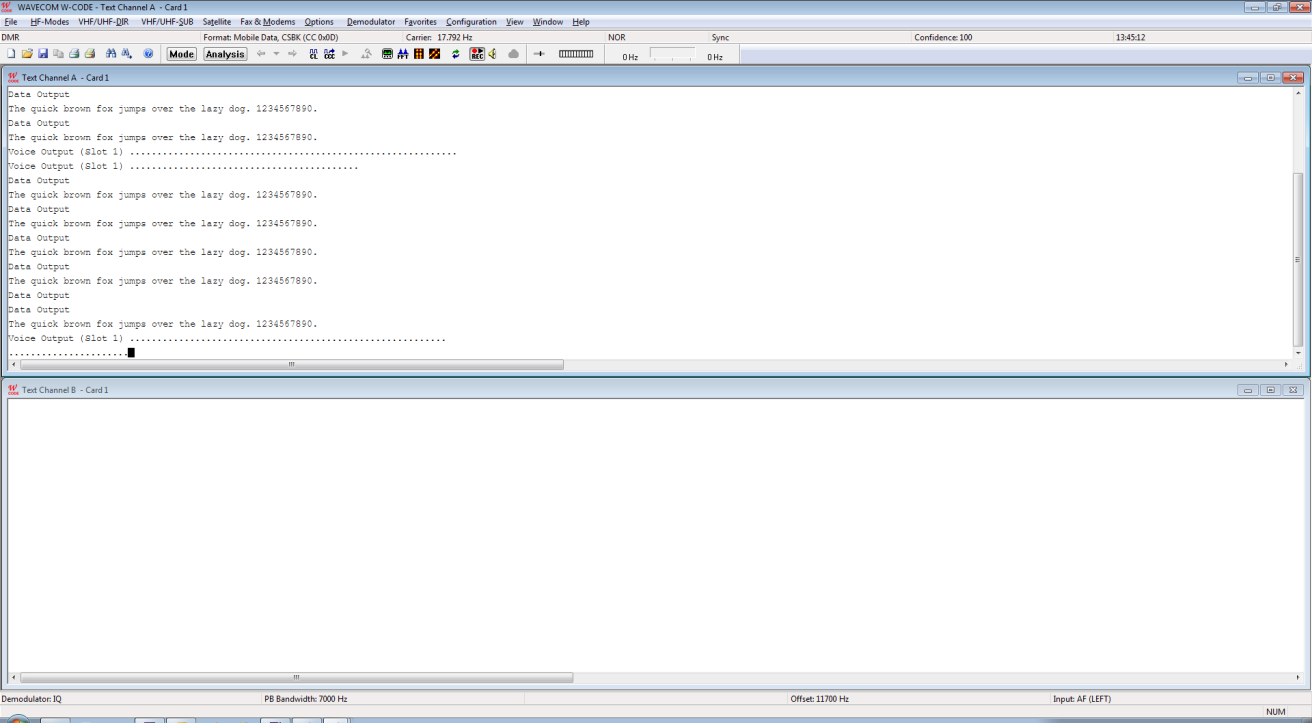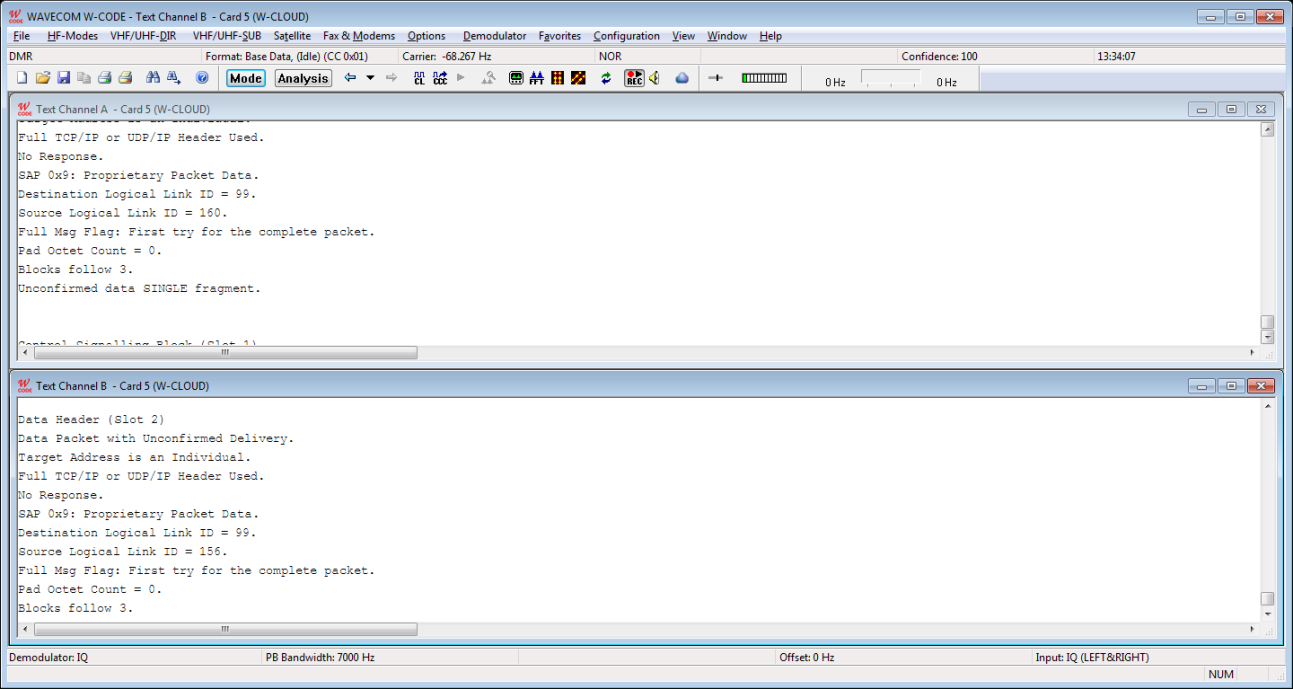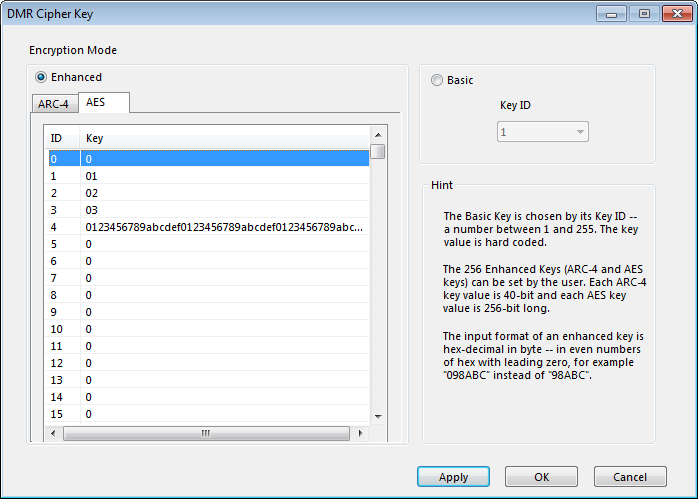
DMR (Digital Mobile Radio) is a two-channel digital TDMA system for the transmission of voice and short text messages.
For voice the AMBE++ (or AMBE+2) codec by DVSI is used. Data transmission accommodates 7-bit ASCII only.
|
Parameter |
Value |
|
Frequency range |
VHF/UHF (136 – 147 / 403 – 470 MHz) |
|
Operation modes |
Digital 2-channel TDMA two-way data and voice system |
|
Modulation |
4FSK with pulse shaping |
|
Symbol rate |
4800 Bd |
|
Receiver settings |
BW = 30 kHz |
|
Input format(s) |
IF |
|
Additional Info |
Data or voice Voice codec: AMBE+2 (3600 bps) |
To use the mode, set Offset to the frequency of the IF output of the receiver and select the correct Polarity. From Options use the Message Type menu to select an output method. If All Frames is selected, data and voice frames as well as all control frames will be displayed. Voice is output in real-time to the speaker. At the same time the latest voice session will be saved in a .wav-file in the default data output directory (see Default Data and Program Folders section). The input bits to the vocoder are saved in Hex in a separate file alongside the .wav file. This feature is useful when the voice session is encrypted. The user can analyze and try to decrypt the bits.
A “Bit Transparent” format is also available in “Message Type”, with this output format the decoded bits will be output before they are processed by the protocol interpreter. In this case no text or voice output is available. This format can be mainly used to analyse the bit stream when it deviates from the user data protocol.
A time stamp is displayed to each frame at the time of decoding. Since the decoder works in real-time, the time of decoding is also the time of signal receiving (with a neglectale delay). The time stamp has a resolution of 1 millisecond (ms). The time stamp display delivers a method to verify whether each received frame is decoded in real-time. In a continous state we can count 16 frames each second in each slot. This matches to the 30 ms frame length in both slot 1 and 2. Both slots are interleaved. The display of this time stamp can be switched off (Options -> Real Timestamp) for a readable data-output.
The display parameter “Confidence” indicates the quality of decoding - a value above 95% indicates a very high decoding quality (low bit error rate), whereas a value below 85% indicates that decoding is unreliable. Minor center frequency deviations are automatically corrected. The value of the Carrier parameter is the center frequency after error correction - this value should remain close to the IF of the receiver.
Besides the parameter “Confidence”, a “Symbol Plane” (in Options menu) displays also the signal quality. The symbol plane below shows a fairely good signal quality – a clear 4-FSK symbol distribution.

DMR Symbol Plane.
Motorola markets DMR radio systems as MOTOTRBO, known sometimes in Asia as XiR.
Wavecom DMR decoder works with all equipments compatible to the ETSI standards, e.g., MOTOTRBO series from Motorola and Hytera DMR devices.
The current implementation complies with the ETSI DMR standard series:
Ø ETSI TS 102 361-1 V2.3.1 (2013-7)
Ø ETSI TS 102 361-2 V2.2.1 (2013-7)
Ø ETSI TS 102 361-3 V1.2.1 (2013-7) and
Ø ETSI TS 102 361-4 V1.6.1 (2014-6)
It covers all three layers of the DMR protocol stack:
Ø Layer 1: Air interface physical layer
Ø Layer 2: Air interface data link layer and
Ø Layer 3: Air interface call control layer.
Wavecom DMR decoder covers all three tier services:
Ø Tier 1: Direct mode
Ø Tier 2: Direct mode and base station communication
Ø Tier 3: Trunking protocol.
Decoding outputs (text, voice and service messages) from the two TDMA slots are sorted in two separate windows. The following two screen shots show a DMR data and voice transmission and real communication on a base station, respectively.

DMR decoding voice and data test messages.

DMR decoding of data messages.
Wavecom DMR decoder can decrypt secured text and voice transmission of Motorola MOTOTRBO series.
To decrypt secured signal user needs to set the correct cipher key by the GUI Options -> DMR Cipher Key.

DMR Cipher Key.
There are two kinds of encryption mode: Basic and Enhanced. For Basic mode the encryption is done by a scrambler. This is a simple but weak encryption and can easily be hacked, because the same text message (plain text) will always deliver the same encrypted bit pattern (cipher text). This delivers some clue on the scrambler. The decoder needs to use the same Key ID (between 1 and 255) as the sender. The scrambler value to each key ID is hardcoded by Motorola and is not sent over the air (OTA) for security reason.
The Enhanced mode is based on two encryption algorithms: Motorola propriatory ARC-4 encryption algorithm with a 40-bit key and the Advanced Encryption Standard (AES) with a 256-bit key. Unlike the Basic mode, it is almost impossible to hack the Enhanced encryption, especially AES-256 – each time a plain text will be encrypted to different a cipher text.
The decoder must use the same key list the sending device. The user can edit up to 256 enhanced keys. Each key is 40-bit (5 bytes) and 256-bit (32 bytes) long, respectively. The input format of the key value is hex-decimal. Use leading zero to make sure that there are even number of hex-decimal digits, e.g., “0123AB” instead of “123AB”. The decoder reads the key ID sent by the encrypting device over the air and uses the corresponding key value for decryption. The key value itself is not sent over the air for security reason.
When the key ID for the basic mode or the key list for the enhanced mode matches to the one used by the sender, a secured text or voice transmission can automatically be decrypted to clear text or voice, respectively. Otherwise the text is unreadable and the voice is unaudible.
Wavecom decryption function has a “late-entry” feature: the user can enter the correct key ID or key value during the decoding session and the output text or voice will get clear immediately.